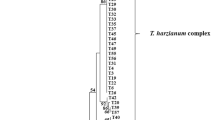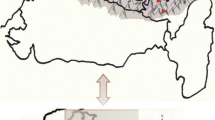Abstract
To understand the diversity of culturable fungi in soil at alpine sites, Rhododendron fruticosa shrubland, Salix cupularis fruticosa shrubland, and Dasiphoru fruticosa shrubland of the Eastern Qilian Mountains were selected to investigate. Three methods, including traditional culturing, rDNA internal transcribed spacer (ITS) sequence analysis, and economical efficiency analysis, were carried out to estimate the diversity of soil culturable fungi of these three alpine shrublands. A total of 35 strains of culturable fungi were cultured by dilution plate technique and were analyzed by rDNA ITS sequence. The diversity indices such as species abundance (S), Shannon-Wiener index (H), Simpson dominance index (D), and Pielou evenness index (J) of Rhododendron fruticosa shrubland, Salix cupularis fruticosa shrubland, and Dasiphoru fruticosa shrubland were ranged between 16 and 17, 2.66–2.71, 0.92, 0.95–0.97 respectively. The results showed that the diversity of soil fungi were abundant in these three types of alpine shrub grasslands, while further study should be done to explore their potential value.
Similar content being viewed by others

References
Allen M F, Allen E B (1992). Mycorrhizae and plant community development: mechanisms and patterns. In: Carroll G C, Wicklow D T, eds. The Fungal Community. New York: Marcel Dekker
Altschul S F, Gish W, Miller W, Myers E W, Lipman D J (1990). Basic local alignment search tool. J Mol Biol, 215(3): 403–410
Anderson I C, Campbell C D, Prosser J I (2003). Potential bias of fungal 18S rDNA and internal transcribed spacer polymerase chain reaction primers for estimating fungal biodiversity in soil. Environ Microbiol, 5(1): 36–47
Atlas R M, Bartha R (1998). Microbial Ecology: Fundamentals and Applications. 4th ed. Menlo Park: Benjamin/Cummings
Bardgett R D, Frankland J C, Whittaker J B (1993). The effects of agricultural management on the soil biota of some upland grasslands. Agric Ecosyst Environ, 45(1–2): 25–45
Borneman J, Skroch P W, O’sullivan K M, Palus J A, Rumjanek N G, Jansen J L, Nienhuis J, Triplett E W (1996). Molecular microbial diversity of an agricultural soil in Wisconsin. Appl Environ Microbiol, 62(6): 1935–1943
Felsenstein J (1985). Confidence limits on phylogenies: an approach using the bootstrap. Evolution, 6: 227–242
Frankland J C, Dighton J, Boddy L (1990). Methods for studying fungi in soil and forest litter. Methods in Microbioly, 22: 343–404
Gams W (1992). The analysis of communities of saprophytic microfungi with special Reference to soil fungi. In: Winterhoff W, ed. Fungi in Vegetation Science. Boston: Kluwer Academic
Gardes M, Bruns T D (1993). ITS primers with enhanced specificity for basidiomycetes—application to the identification of mycorrhizae and rusts. Mol Ecol, 2(2): 113–118
Griffiths B S, Ritz K, Bardgett R D, Cook R, Christensen S, Ekelund F, Sørensen S J, Bååth E, Bloem J, Ruiter P C, Dolfing J, Nicolardot B (2000). Ecosystem response of pasture soil communities to fumigation-induced microbial diversity reductions: an examination of the biodiversity ecosystem function relationship. Oikos, 90(2): 279–294
Hall T A (1999). BioEdit: a user-friendly biological sequence alignment editor and analysis program for Windows 95/98/NT. Nucleic Acids Symp Ser, 41: 95–98
Hawksworth D L (2001). The magnitude of fungal diversity: the 1.5 million species estimate revisited. Mycol Res, 105(12): 1422–1432
Hibbett D S, Ohman A, Glotzer D, Nuhn M, Kirk P, Nilsson R H (2011). Progress in molecular and morphological taxon discovery in fungi and options for formal classification of environmental sequences. Fungal Biol Rev, 25(1): 38–47
Hirsch P R, Mauchline T H, Clark I M (2010). Culture-independent molecular techniques for soil microbial ecology. Soil Biol Biochem, 42(6): 878–887
Kjøller A, Struwe S (1982). Microfungi in ecosystems: fungal occurrence and activity in litter and soil. Oikos, 39(3): 391–422
Kowalchuk G A, Gerards S, Woldendorp J W (1997). Detection and characterization of fungal infections of Ammophila arenaria (marram grass) roots by denaturing gradient gel electrophoresis of specifically amplified 18s rDNA. Appl Environ Microbiol, 63(10): 3858–3865
Kuninaga S, Natsuaki T, Takeuchi T, Yokosawa R (1997). Sequence variation of the rDNA ITS regions within and between anastomosis groups in Rhizoctonia solani. Curr Genet, 32(3): 237–243
Larena I, Salazar O, González V, Julián M C, Rubio V (1999). Design of a primer for ribosomal DNA internal transcribed spacer with enhanced specificity for ascomycetes. J Biotechnol, 75(2–3): 187–194
Li Y C, Yang Z L, Tolgor B (2009). Phylogenetic and biogeographic relationships of Chroogomphus species as inferred from molecular and morphological data. Fungal Divers, 38: 85–104
Mello A, Napoli C, Murat C, Morin E, Marceddu G, Bonfante P (2011). ITS-1 versus ITS-2 pyrosequencing: a comparison of fungal populations in truffle grounds. Mycologia, 103(6): 1184–1193
Swofford D L (2002). PAUP 4.0 b10: Phylogenetic Analysis Using Parsimony. Sunderland: Sinauer Associates
Tabacchioni S, Chiarini L, Bevivino A, Cantale C, Dalmastri C (2000). Bias caused by using different isolation media for assessing the genetic diversity of a natural microbial population. Microb Ecol, 40 (3): 169–176
Tebbe C C, Vahjen W (1993). Interference of humic acids and DNA extracted directly from soil in detection and transformation of recombinant DNA from bacteria and a yeast. Appl Environ Microbiol, 59(8): 2657–2665
Thompson J D, Gibson T J, Plewniak F, Jeanmougin F, Higgins D G (1997). The CLUSTAL_X windows interface: flexible strategies for multiple sequence alignment aided by quality analysis tools. Nucleic Acids Res, 25(24): 4876–4882
Thorn R G, Reddy C A, Harris D, Paul E A (1996). Isolation of saprophytic basidiomycetes from soil. Appl Environ Microbiol, 62 (11): 4288–4292
Tilman D A, Knops J, Wedin D (1997). The influence of functional diversity and composition on ecosystem processes. Science, 277 (5330): 1300–1302
Unterseher M, Jumpponen A, Opik M, Tedersoo L, Moora M, Dormann C F, Schnittler M (2011). Species abundance distributions and richness estimations in fungal metagenomics—lessons learned from community ecology. Mol Ecol, 20(2): 275–285
van Elsas J D, Duarte G F, Keijzer-Wolters A, Smit E (2000). Analysis of the dynamics of fungal communities in soil via fungal-specific PCR of soil DNA followed by denaturing gradient gel electrophoresis. J Microbiol Methods, 43(2): 133–151
Wardle D A, Giller K E (1996). The quest for a contemporary ecological dimension to soil biology. Soil Biol Biochem, 28(12): 1549–1554
White T J, Bruns T, Lee S, Taylor J (1990). Amplification and direct sequencing of fungal ribossomal RNA genes for phylogenetics. In: Nis MA, Gelfand D H, Sninsky J J, White JW, eds. PCR Protocols: a Guide to Methods and Applications. New York: Academic Press
Xu L, Ravnskov S, Larsen J, Nilsson R H, Nicolaisen M (2012). Soil fungal community structure along a soil health gradient in pea fields examined using deep amplicon sequencing. Soil Biol Biochem, 46: 26–32
Author information
Authors and Affiliations
Corresponding author
Additional information
Junzhong Zhang is a Research Assistant at Key Laboratory of Forest Disaster Warning and Control in Yunnan Province, Southwest Forestry University, China. He received his M.S. and Ph. D. in grassland biodiversity at Gansu Agricultural University, China in 2007 and 2010, respectively. As a visiting scholar he studied at College of Environmental Sciences, Tsinghua University during September 2011 to July 2012. His research areas focus on environmental microorganisms and plant pathogens. Dr. Zhang has published over 10 papers, and one book.
Baiying Man is a teacher at Guangzhou University Sontan College, China. He holds his B.S. in life sciences from the Tianshui Normal University and M.S. in agriculture from Gansu Agricultural University, China in 2005 and 2008, respectively. His research areas focus on grassland microorganisms and plant endophytic bacteria. He has published five scientific papers on grassland microorganisms and plant endophytic bacteria.
Benzhong Fu received his B.S. in plant protection from Hubei Agricultural College, **gzhou, China in 2005, M.S. in plant pathology from Yunnan Agricultural University, China in 2009, and Ph.D. in plant pathology from Chinese Academy of Agricultural Sciences, China. He was a lecturer in Southwest Forestry University from July 2009 to September 2012. Since then, He employed in Hubei Engineering University, China. His current research interesting includes microbial molecular ecology, molecular plant-microbe interactions, and interaction between different microbes. Dr. Fu is the membership of Plant Pathology Society of Hubei Province, China.
Li Liu earned his M.S. in plant pathology from Fujian Agriculture and Forestry University, Fuzhou City, China in 2005. Now her main study field is the microbe of agriculture. She had worked in Mudanjiang Agriculture Institute, Heilongjiang Academy of Agriculture Science from August 2000 to August 2002. Now she worked in Southwest Forestry University, China. Her current research interest is microbe of agriculture.
Changzhi Han graduated from Nan**g Agricultural University, China in August 2010, and now he is a Ph.D. candidate in agronomy, specializing in plant pathology and research direction is fungal genetic and functional group. From August 2010, he worked at the Southwest Forestry University, China, and he is interesting in the forest fungal disease genetic and pathogenic gene function.
Rights and permissions
About this article
Cite this article
Zhang, J., Man, B., Fu, B. et al. The diversity of soil culturable fungi in the three alpine shrub grasslands of Eastern Qilian Mountains. Front. Earth Sci. 7, 76–84 (2013). https://doi.org/10.1007/s11707-012-0345-8
Received:
Accepted:
Published:
Issue Date:
DOI: https://doi.org/10.1007/s11707-012-0345-8



